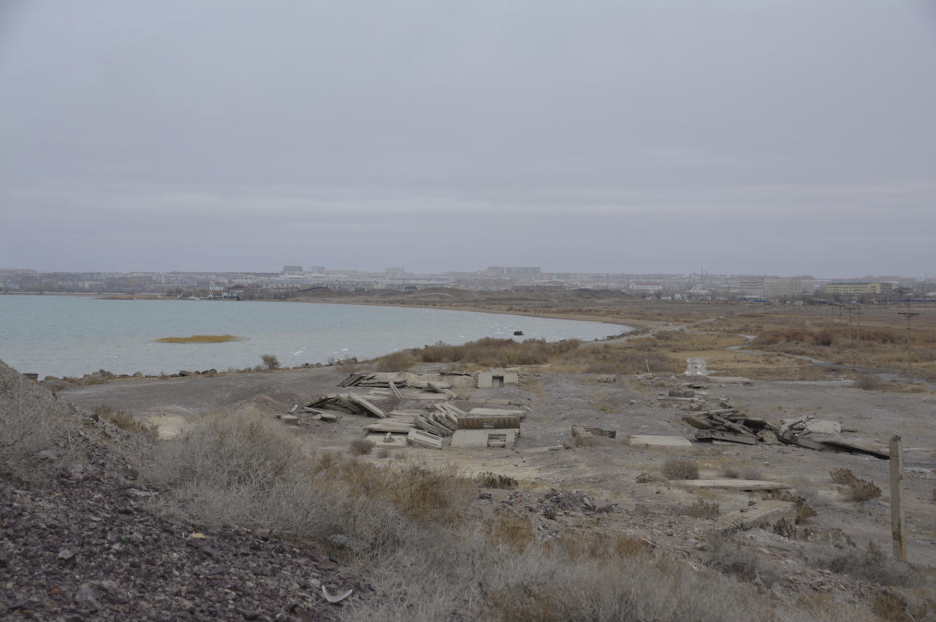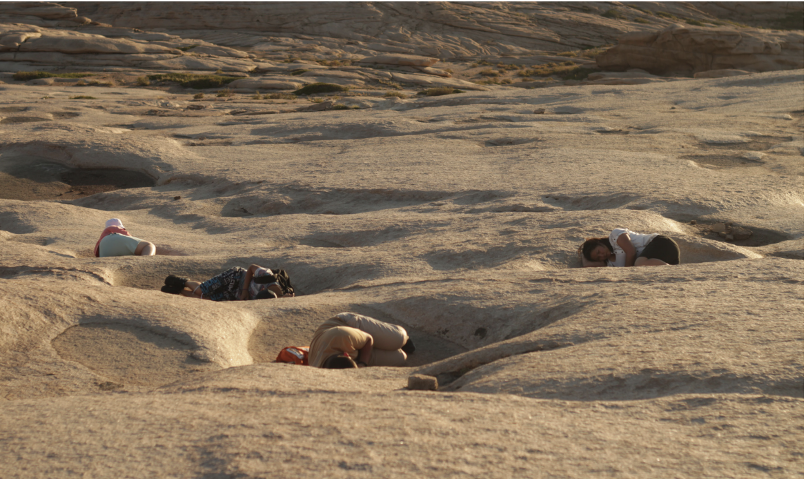Lake Balkhash holds its breath and waits
By Dilraba Anayatova
Water connects us. It holds our memories, sustains life, and, most importantly, shapes entire complex ecosystems. Yet, in Kazakhstan, where vast deserts and semi-deserts dominate the landscape, water security is constantly threatened. Lake Balkhash, one of the country’s most vital freshwater sources, is facing a growing crisis. Just like the Aral Sea before it, Balkhash is at risk of shrinking beyond recovery, and its future remains uncertain, threatened by overconsumption, industrial expansion, and transboundary water disputes. This unfolding crisis is not only about a single lake; it reflects deeper global tensions over how we value and manage our shared natural resources.
A divided lake and its lifeline
Located in eastern Kazakhstan, Lake Balkhash is unique—it is divided into two parts, with freshwater in the west and saline water in the east. It is the 15th largest lake in the world, fed by seven rivers, the most important being the Ili River, which flows from China’s mountainous region. Its distinctive geography makes it ecologically significant.
Balkhash Lake has always been vulnerable by nature as its fluctuation is cyclical, depending on the Ili River, which is the lifeline of Lake Balkhash and supplies 80% of its water. In the 1960s, extensive irrigation started with the diverting of the river to the Hydroelec Reservoir Kapchagay to fill it, drastically decreasing Balkhash Lake. Till today, Kapchagay generates electricity for one-fifth of Kazakhstan’s population, including the biggest city, Almaty.
Rising pressures from China
At the same time, this crucial water source is under increasing pressure due to China’s agricultural expansion. The Ili River is one of the most fertile rivers in China’s region, making it a prime location for cotton and rice cultivation as well as large-scale farming, bringing contaminated waters into the lake. Overconsumption of water at the top of the Ili River in China resulted in not only a drastic decline of the Balkhash Lake but also an exponential increase in its salinity in both the Ili River and the lake. In 2007, the Kazakh government offered China the opportunity to reduce its water pollution and consumption in exchange for lowered Kazakh products. Unfortunately, China declined the offer. In the study of 2021, which evaluated the vulnerability of the Ili-Balkhash basin, researchers claimed, “If the hydro-climatic regime of the Ili for 2020–2060 remains unchanged compared to the past 50 years, and agriculture continues to expand in China, future water supplies will become increasingly strained” adding that Ili-Balkhash basin has historically been prone to environmental shortages. Any further increase in water use will make these shortages more frequent and severe. Yet, neither Kazakhstan nor China is planning to decrease water consumption in the future. Without cooperative, transboundary solutions, the burden of ecological collapse will fall hardest on local communities and future generations.

Disappearing biodiversity
Even though biodiversity started to decline in the 1970s because of industrial, military, and mining activities, the Balkhash region is home to a rich variety of terrestrial species, including 50 mammal species and 269 bird species. Among them, Goitered Gazelle, Marbled Polecat, White-headed Duck, Red-breasted Goose, and Ship Sturgeon goitered gazelles, caracals are increasingly threatened due to habitat loss, overgrazing, and deforestation. The destruction of riparian forests and steppe ecosystems has also led to a sharp decline in pollinators, which is negatively impacting Pelican colonies in the Balkhash Lake, which are among the last in the country. These ecological disruptions threaten both biodiversity and the traditional livelihoods of local herders and farmers.
Before 1939, people's main activity was fishing. There were several small fishing towns. However, the discovery of a large copper deposit transformed the area into a central industrial hub with six main industrial facilities, including three mines, one concentrating mill, one copper smelting plant, one combined heat and power plant, and a number of auxiliary shops and enterprises. All these require the use of freshwater, which is dangerously scarce. Most importantly, Kazakhmys, the owner of these industries, was sanctioned for breaking environmental standards and denying responsibility for the contamination of large bodies of water. The transition from traditional livelihoods to the extractive industry has deepened the ecological and social vulnerabilities of the region.
Fishing communities have been severely weakened by overfishing and water pollution in Lake Balkhash. During the 1960s, 70% of the 30,000 tons of fish produced each year by the lake were valuable species. This amount had dropped to approximately 6,600 tons by the 1990s, leaving just 49 tons of valuable fish. Invasive species importation and illegal fishing have further degraded the water's biodiversity. The environment of the lake is becoming more and more vulnerable due to a lack of conservation initiatives and insufficient regulation, endangering local fisheries and food security. What was once a flourishing aquatic system has now become a cautionary tale about unchecked exploitation and poor environmental governance.
Nuclear past, present and an uncertain nuclear future
Despite Kazakhstan’s painful nuclear history, the government has renewed efforts to build nuclear power plants, sparking widespread concern among citizens. From 1949 to 1989, the Soviet Union tested the RDS-1, the first atomic weapon in Kazakhstan, completely top-secret. There were 456 nuclear tests, including 340 subterranean and 116 atmospheric explosions with mushroom clouds, leaving many people's lives destroyed. Of course, the nuclear power plant is different, asserts President Kassym-Jomart Tokayev, who was elected in 2019, says building it with international assistance, including Russia, China, France, and South Korea, would be "the biggest project in the history of independent Kazakhstan." This responsibility will be placed on the already environmentally vulnerable Balkhash Lake.
Scholars and environmental scientists have been warning about the degradation of Balkhash’s environment the nuclear power plant building was discussed in the “Balkhash-2020” international forum. After the referendum in 2024, it was decided to build in Balkhash, and the lake’s water would be used to cool the reactors. Now, scholars advocate for at least a smaller reactor to be installed, minimizing thermal pollution. Even so, any contamination could have severe consequences for the lake's ecosystem and surrounding communities. Building a nuclear power plant will solve 12% of the electricity insufficiencies by 2030; it will also “surely speed up its death,” concludes a Caspian Policy Center expert. In seeking to power the future, we may be extinguishing the lifeblood of a delicate ecosystem already hanging by a thread.
The future of water… and of life
Water is life. Lake Balkhash, as one of the most vital freshwater bodies in Kazakhstan, is facing an uncertain future. Scientists warn that if natural water decreases and water consumption rises, the lake's water level will drop below the critical threshold of 341 meters above sea level. Within ten years, fresh water will not only be available for human consumption but also disrupt ecological processes and further exacerbate biodiversity loss. Another study demonstrates a need for transboundary governance if China continues agricultural use at the same pace (not even increase) and Kazakhstan continues overconsuming the lake for industrial, farming, and energy purposes. These four underlying tenets creating water scarcity in Lake Balkhash are not unique to Kazakhstan, and therefore, the lessons we can learn from the history and future of this lake have tremendous implications for global understandings of water scarcity. The fate of Lake Balkhash calls for immediate action that requires sustainable water management and stronger environmental policies.
For now, Balkhash holds its breath, waiting to see what humanity chooses.
Grassroots art as ecological action
Amid political inaction, local artists and activists are leading a powerful movement to protect Lake Balkhash. Through the Care for Balkhash initiative, the Artcom Platform brings together youth, scientists, and communities using art as a tool for memory, resistance, and restoration.
From land-based interventions like “Our Bektau Ata” to public exhibitions and documentaries, their work turns care into action. These creative acts raise awareness, build solidarity, and help reimagine a future where the lake—and its people—can thrive.
"We paint the lake as we remember it—not as it is."
To learn more, visit careforbalkhash.org or follow @careforbalkhash.


